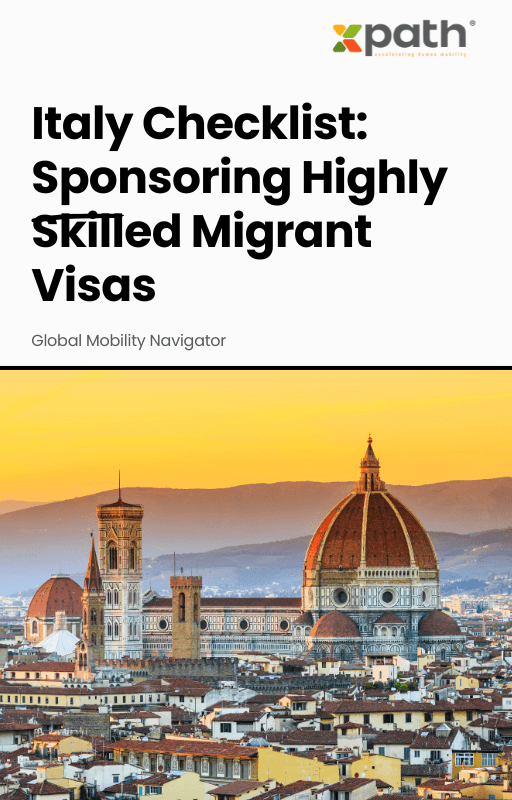Italy Checklist: Sponsoring Highly Skilled Migrant Visas
Grab a copy of a guide to international employee relocation
View E-bookRemember when “work” meant rows of desks, office commutes, and maybe the odd video call? Those days are long gone. Now, the international workforce is breaking free from traditional cubicles and coffee room chats. Remote work and hybrid models—where employees split time between home and office—are becoming the norm, not the exception. But what really enables this borderless way of working? The unsung hero is technology, specifically modern global mobility solutions. Let’s dig into how tech powers this transformation, streamlining everything from compliance to employee experience and why it’s crucial for organizations aiming to thrive in the new world of work.
First, let’s set the context. The pandemic accelerated a shift already in motion. By 2023, a Gartner study found that 39% of knowledge workers globally were working either fully remote or in a hybrid model. And it’s not a passing phase—70% of global companies anticipate hybrid work as their default. Employees are demanding flexibility, and talent is now sourced across international borders.
This huge leap means HR and mobility managers must juggle everything from digital nomad visas to tax compliance and cultural integration—often for people they can’t simply call into the office. Old-school pen-and-paper policies simply aren’t up to the task. Enter: cutting-edge global mobility solutions.
The market for global mobility technology is booming. According to a 2022 MarketsandMarkets report, the global mobility software market is expected to surpass $15 billion by 2026 with an average annual growth rate of 17%. Why such rapid growth? Because companies can’t risk falling behind—whether it’s losing out on top talent or failing to comply with local labor laws.
One striking stat from Deloitte’s 2023 Global Mobility Trends Survey: 76% of mobility teams are increasing investment in digital transformation. They’re pivoting because they’ve seen that manual processes and spreadsheets cannot keep up with hundreds of international personnel, each with unique requirements and legal obligations.
Let’s look at a real-world example. Take a Fortune 500 company with employees distributed across 40 countries. Previously, coordinating assignments and remote placements involved multiple vendors, manual compliance tracking, and lengthy onboarding. By centralizing mobility management through a digital platform like xpath.global, they achieved:
– A 60% reduction in time-to-deploy for mobile employees
– Seamless integration of relocation and risk management services
The upshot? More agility, less risk, and a better employee experience, all enabled by a single tech stack.
Of course, global hybrid and remote mobility isn’t a walk in the park. Key challenges include:
Compliance Maze: Every country—and often each region—has unique rules about work permits, taxes, and data security. Manual tracking is a recipe for mistakes and penalties. Smart mobility platforms centralize vendors, giving HR leaders a bird’s-eye view of risks and deadlines.
Onboarding at Distance: How do you make an employee feel at home when “home” is a time zone away? From digital document collection to regional orientation resources and central messaging, tech solutions like xpath.global streamline onboarding worldwide, ensuring cultural and regulatory nuances aren’t lost in translation.
Visibility & Analytics: Mobility isn’t just about moving people; it’s about measuring ROI on assignments, tracking satisfaction, and making evidence-based decisions. Advanced platforms provide dashboards and analytics—so you actually see what’s working and what isn’t, rather than guessing.
The future of global work isn’t “one size fits all.” Will cross-border assignments disappear? Not at all—they’re just evolving. Temporary business travelers, permanent expats, frequent flyers, and, increasingly, digital nomads each require unique mobility support. Technology makes it possible to offer tailored solutions, quickly adapting to changes like new visa regimes, public health mandates, or geopolitical risk. It shifts global mobility from a “cost center” headache to a strategic enabler of talent acquisition and retention.
With dozens of platforms vying for attention, how do you pick the right one? Industry analysts and HR leaders point to factors like:
– Customizable workflows to match company policy
– Intuitive dashboards and reporting
– Seamless integration with HRIS and payroll systems
– On-demand support and local expertise (because global isn’t the same as generic)
Providers like xpath.global check these boxes, leveraging both technology and an international partner network to deliver a seamless, end-to-end experience for both HR and employees.
The shift to remote and hybrid global teams is here to stay. If you want to attract and retain top talent, ensure compliance, and create an outstanding employee experience—technology isn’t optional, it’s essential. The right global mobility solution empowers your organization to move people (and ideas) faster, further, and with less hassle. Are you ready to reboot your mobility playbook?
What is a global mobility solution?
A global mobility solution is a technology platform or suite of services that helps organizations manage international employee moves, assignments, compliance, and onboarding in one place—especially handy for hybrid and remote work.
Why is technology essential for hybrid and remote mobility?
Technology automates complex tasks, ensures compliance across borders, streamlines onboarding, and provides visibility to HR managers—all critical for supporting employees wherever they work.
Is global mobility only for big enterprises?
Nope! While large companies have big mobility programs, even small and mid-sized businesses benefit from more efficient, compliant, and attractive global mobility solutions. The gig economy and cross-border hiring are on the rise for all.
How does xpath.global support remote and hybrid mobility?
xpath.global centralizes everything: compliance, onboarding, vendor management, and analytics. It’s designed to give both HR and mobile employees a seamless, transparent, and compliant experience—wherever they are in the world.
Ready to transform your mobility program? Explore xpath.global’s solutions.

Italy Checklist: Sponsoring Highly Skilled Migrant Visas
Grab a copy of a guide to international employee relocation
View E-book